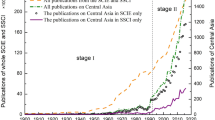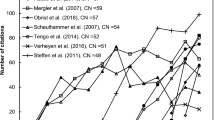Abstract
This paper deals with the bibliometric study of the research concerning the San Andreas Fault System (SAFS), an extraordinary example of a complex boundary between the North of America and the Pacific plates that can be seen, followed and studied on land for hundreds of kilometers through California, in the USA. The bibliometric analysis discussed here considers the time span of 23 years, from 1991 to 2013. The bibliographic databases taken as a reference are the Science Citation Index Expanded (SCI-EXPANDED) and the Social Sciences Citation Index (SSCI) accessed via Web of Science Core Collection. After having selected the proper search terms to fix the query and extracting the useful information from the two Web of Science (WoS) databases, we performed the analysis of the outputs paying attention to the document typology and languages, journals, subject categories, authors, articles, countries, institutions, and keywords. The results of this study can (1) contribute to see how the research on SAFS has changed over the time and suggest clues about the future investigation trends, (2) help scientists or institutions to build a research network and find strategic partners, (3) suggest scientists and institutions the dissemination strategies, and (4) provide helpful information to researchers wishing to embark on work in this area.











Similar content being viewed by others
References
Bakun WH, Aagaard B, Dost B, Ellsworth WL, Hardebeck JL, Harris RA, Ji C, Johnston MJS, Langbein J, Lienkaemper JJ, Michael AJ, Murray JR, Nadeau RM, Reichle MS, Reasenberg PA, Roeloffs EA, Shakal A, Simpson RW, Waldhauser F (2005) The 2004 Parkfield (CA) earthquake: implications for prediction and hazard assessment. Nature 437:969–974
Becker TW, Hardebeck JL, Anderson G (2005) Constraints on fault slip rates of the southern California plate boundary from GPS velocity and stress inversions. Geophys J Int 160:634–650. doi:10.1111/j.1365246X.2004.02528.x
Black BD, Hecker S, compilers (1999) Fault number 2470, Elsinore fault (fold), in Quaternary fault and fold database of the United States: U.S. Geological Survey website, http://earthquakes.usgs.gov/hazards/qfaults. Accessed 23 Jul 2014
Bradbury KK, Barton DC, Solum JG, Draper SD, Evans JP (2007) Mineralogic and textural analyses of drill cuttings from the San Andreas Fault Observatory at Depth (SAFOD) boreholes: initial interpretations of fault zone composition and constraints on geologic models. Geosphere 3(5):299–318. doi:10.1130/GES00076.1
Bryant WA, compiler (2000) Fault number 29a/c, Bartlett Springs fault system, Bartlett Springs section, in Quaternary fault and fold database of the United States: U.S. Geological Survey website, http://earthquakes.usgs.gov/hazards/qfaults. Accessed 23 Jul 2014
Bryant WA, Matthew LM, compilers (2002) Fault number 1a-j, San Andreas fault zone, all sections, in Quaternary fault and fold database of the United States: U.S. Geological Survey website, http://earthquakes.usgs.gov/hazards/qfaults. Accessed 23 Jul 2014
Bryant WA, Cluett SE, compilers (1999a) Fault number 54a/b/c/d, Calaveras fault zone, Central Calaveras fault section, in Quaternary fault and fold database of the United States: U.S. Geological Survey website, http://earthquakes.usgs.gov/hazards/qfaults. Accessed 23 Jul 2014
Bryant WA, Cluett SE, compilers (1999b) Fault number 60a/b, San Gregorio fault zone, Sur Region section, in Quaternary fault and fold database of the United States: U.S. Geological Survey website, http://earthquakes.usgs.gov/hazards/qfaults. Accessed 23 Jul 2014
Bryant WA, Cluett SE, compilers (2000) Fault number 55a/b/c, Hayward fault zone, Southeast Extension section, in Quaternary fault and fold database of the United States: U.S. Geological Survey website, http://earthquakes.usgs.gov/hazards/qfaults. Accessed 23 Jul 2014
Bryant WA, Cluett SE, compilers (2002) Fault number 37, Green Valley fault, in Quaternary fault and fold database of the United States: U.S. Geological Survey website, http://earthquakes.usgs.gov/hazards/qfaults. Accessed 23 Jul 2014
Burgmann R, Pollard DD, Martel SJ (1994) Slip distributions on faults: effects of stress gradients, inelastic deformation, heterogeneous hostrock stiffness, and fault interaction. J Struct Geol 16:1675–1690
Burgmann R, Hilley G, Ferretti A, Novali F (2006) Resolving vertical tectonics in the San Francisco Bay area from permanent scattered InSAR and GPS analysis. Geology 34:221–224
Chiu WT, Ho YS (2007) Bibliometric analysis of tsunami research. Scientometrics 73:3–17
Chuang KY, Huang YL, Ho YS (2007) A bibliometric and citation analysis of stroke-related research in Taiwan. Scientometrics 72(2):201–212
Dawson TE, McGill SF, Rockwell TK (2003) Irregular recurrence of paleoearthquakes along the central Garlock Fault near El Paso Peaks, California. J Geophys Res 108(B7):2356. doi:10.1029/2001JB001744
Dolan JF, Sieh K, Rockwell TK (2000) Late Quaternary activity and seismic potential of the Santa Monica fault system, Los Angeles, California. Geol Soc Am Bull 112:1559–1581
Ellsworth WL (1990) Earthquake history, 1769-1989. In Wallace RE (Ed.) The San Andreas fault system, California. (pp. 153–190). U.S. Geological survey professional paper 1515. Washington
Franceschini F, Maisano D (2010) A survey of quality engineering-management journals by bibliometric indicators. Qual Reliab Eng Int 26(6):593–604. doi:10.1002/qre.1083
Garcia-Ramon MD, Caballé A (1998) Situating gender geographies: a bibliometric analysis. Tijdschr Econ Soc Geogr 89(2):210–216
Garfield E (1990) KeyWords plus: ISI’s breakthrough retrieval method, part 1, expanding your searching power on current contents on diskette. Curr Contents 32:5–9
Goldstein R, Zebker H, Werner C (1998) Satellite radar interferometry: two-dimensional phase unwrapping. Radio Sci 23:713–720
Gotze H (1997) The English language in scientific publishing. Publ Res Q 13(1):52–72
Grant J, Cottrell R, Cluzeau F, Fawcett G (2000) Evaluating ‘payback’ on biomedical research from papers cited in clinical guidelines: applied bibliometric study. Br Med J 320. doi:10.1136/bmj.320.7242.1107
Hart EW, compiler (1998) Fault number 32, Rodgers Creek fault, in Quaternary fault and fold database of the United States: U.S. Geological Survey website, http://earthquakes.usgs.gov/hazards/qfaults. Accessed 23 Jul 2014
Hart EW, Bryant WA, compilers (2001) Fault number 30a/b, Maacama fault zone, northern section, in Quaternary fault and fold database of the United States: U.S. Geological Survey website, http://earthquakes.usgs.gov/hazards/qfaults. Accessed 23 Jul 2014
Janssen C, Wirth R, Reinicke A, Rybacki E, Naumann R, Wenk HR, Dresen G (2011) Nanoscale porosity in SAFOD core samples (San Andreas Fault). Earth Planet Sci Lett 301:179–189
Lawson AC (1895) Sketch of the geology of the San Francisco peninsula: U.S. Geol Surv Ann Rep 15:439–473
Liu X, Zhan FB, Hong S, Niu B, Liu Y (2012) A bibliometric study of earthquake research: 1900-2010. Scientometrics 92(3):747–765. doi:10.1007/s11192-011-0599-z
Lyons S, Sandwell D (2003) Fault creep along the southern San Andreas from interferometric synthetic aperture radar, permanent scatterers, and stacking. J Geophys Res 108. doi:10.1029/2002JB001831
Marshall GA, Stein RS, Thatcher W (1991) Faulting geometry and slip from coseismic elevation changes: The 18 October 1989, Loma Prieta, California, earthquake. Bull Seismol Soc Am 81:1660–1693
Marx W, Bornmann L (2013) The emergence of plate tectonics and the Kuhnian model of a paradigm shift: a bibliometric case study based on the Anna Karenina principle. Scientometrics 94(2):595–614. doi:10.1007/s11192-012-0741-6
Massonnet D, Rossi M, Carmona C, Adragna F, Peltzer G, Feigl K, Rabaute T (1993) The displacement field of the Landers earthquake mapped by radar interferometry. Nature 364(6433):138–142
Niu B, Hong S, Yuan J, Peng S, Wang Z, Zhang X (2014) Global trends in sediment-related research in earth science during 1992–2011: a bibliometric analysis. Scientometrics 98(1):511–529
Rogers AE, Ingalls RP (1969) Venus: mapping the surface reflectivity by radar interferometry. Science 165(3895):797–799
Spencer JQG, Hadizadeh J, Gratier JP, Doan ML (2012) Dating deep? Luminescence studies of fault gouge from the San Andreas Fault Zone 2.6 km beneath Earth’s surface. Quat Geochronol 10. doi:10.1016/j.quageo.2012.1004.1023
Tang L, Walsh J (2010) Bibliometric fingerprints: name disambiguation based on approximate structure equivalence of cognitive maps. Scientometrics 84:763–784
Toda S, Stein RS (2002) Response of the San Andreas fault to the 1983 Coalinga-Nuñez earthquakes: an application of interaction-based probabilities for Parkfield. J Geophys Res 107(B4):11029–11044
Treiman JJ, compiler (1999) Fault number 132, Imperial fault, in Quaternary fault and fold database of the United States: U.S. Geological Survey website, http://earthquakes.usgs.gov/hazards/qfaults. Accessed 23 Jul 2014
Treiman JJ, compilers (1998) Fault number 126a/c/d/e/g, Elsinore fault zone, Glen Ivy section, in Quaternary fault and fold database of the United States: U.S. Geological Survey website, http://earthquakes.usgs.gov/hazards/qfaults. Accessed 23 Jul 2014
Treiman JA, Treiman JJ, compilers (1998) Fault number 126b/f, Elsinore fault zone, Chino section, in Quaternary fault and fold database of the United States: U.S. Geological Survey website, http://earthquakes.usgs.gov/hazards/qfaults. Accessed 23 Jul 2014
Treiman JA, Lundberg MM, compilers (1999) Fault number 125a/b/c/d/e/f/g, San Jacinto fault, Borrego Mountain section, in Quaternary fault and fold database of the United States: U.S. Geological Survey website, http://earthquakes.usgs.gov/hazards/qfaults. Accessed 23 Jul 2014
Wallace RE (1990) General features. In Wallace RE (Ed.) The San Andreas Fault System, California (pp. 3–12). U.S. Geological survey professional, paper 1515. Washington
Waltman L, Van Eck NJ, Noyons E (2010) A unified approach to mapping and clustering of bibliometric networks. J Inf 4(4):629–635
Wang Q, Yang Z, Yang Y, Long C, Li H (2014) A bibliometric analysis of research on the risk of engineering nanomaterials during 1999-2012. Sci Total Environ 473–474:483–489. doi:10.1016/j.scitotenv.2013.12.066
Wiersberg T, Erzinger JA (2007) Helium isotope cross-section study through the San Andreas Fault at seismogenic depths. Geochem Geophys Geosyst 88(1):Q01002. doi:10.1029/2006GC001388
Zhang H, Thurber C, Bedrosian B (2009) Joint inversion of Vp, Vs, and Vp/Vs at SAFOD, Parkfield, California. Geochem Geophys Geosyst 10, Q11002
Author information
Authors and Affiliations
Corresponding author
Rights and permissions
About this article
Cite this article
Gizzi, F.T. Worldwide trends in research on the San Andreas Fault System. Arab J Geosci 8, 10893–10909 (2015). https://doi.org/10.1007/s12517-015-1878-4
Received:
Accepted:
Published:
Issue Date:
DOI: https://doi.org/10.1007/s12517-015-1878-4




